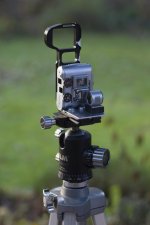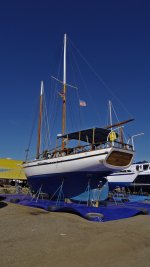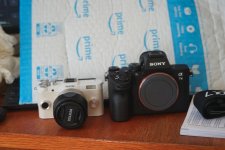Abbazz
6x9 and be there!
I love miniature cameras and I have used a lot of film minis and subminis. Nowadays, I also like to shoot digital but do not enjoy using a phone to take pictures. I have two miniature digital cameras that I particularly like to take with me everyday, the DxO One and the Sony RX0.
What I find surprising is that these modern cameras are maybe not so revolutionary when we look at them next to their ancestors:
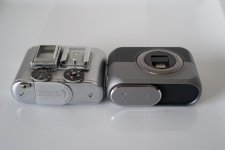
The Tessina doesn't look out of place next to the DxO One. Both cameras have the same general shape and both are are equipped with a sliding lens cover.
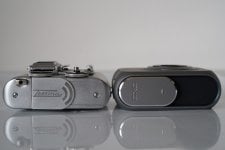
The digital camera is thicker than its mechanical ancestor though. And the Tessina manages to take 14x21mm pictures on 35mm film, while the DxO One has a 1"sensor taking 9.6x12.8mm pictures.
As for the Sony RX0, it does remind me of a shrunk version of my beloved Rollei 35:
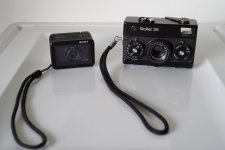
Both cameras have a similar boxy shape and are equipped with a Zeiss Tessar (or not). Both deliver great pictures for the people who know how to use them but the Sony has a much wider lens and a much smaller imager.
Cheers!
Abbazz
What I find surprising is that these modern cameras are maybe not so revolutionary when we look at them next to their ancestors:

The Tessina doesn't look out of place next to the DxO One. Both cameras have the same general shape and both are are equipped with a sliding lens cover.

The digital camera is thicker than its mechanical ancestor though. And the Tessina manages to take 14x21mm pictures on 35mm film, while the DxO One has a 1"sensor taking 9.6x12.8mm pictures.
As for the Sony RX0, it does remind me of a shrunk version of my beloved Rollei 35:

Both cameras have a similar boxy shape and are equipped with a Zeiss Tessar (or not). Both deliver great pictures for the people who know how to use them but the Sony has a much wider lens and a much smaller imager.
Cheers!
Abbazz
skucera
Well-known
Abbazz, I too love little gadgety cameras. I'd never seen the DxO One or the Sony RX0. Thanks for posting them. I think I have hours of googling ahead of me to learn about these little things. 
Thanks,
Scott
Thanks,
Scott
Abbazz
6x9 and be there!
Hi Scott,Abbazz, I too love little gadgety cameras. I'd never seen the DxO One or the Sony RX0. Thanks for posting them. I think I have hours of googling ahead of me to learn about these little things.
These little marvels are indeed sooo addictive!
The DxO One was designed as a connected camera to use tethered to a smartphone. The last firmware update allowed to use it as a self contained camera by allowing the small B&W screen at the back of the camera to display a highly pixellated picture giving a rough idea of the scene being photographed. In fact, this small viewfinder is quite usable to take snapshots, it even adds an element of uncertainty or randomness to the picture... At least, it is not much worse than the tiny reflex finder of the Tessina! The lens has a fast f/1.8 aperture and the same field of view as a 32mm lens on 24x36, making it highly suitable for candid portraits and family snapshots in available light. It is out of production for quite a while now but still available new at discount prices. If someone is interested, I would advise to look for the somewhat rarer Android version because it is much more future proof than the more common IOS version.
As for the Sony RX0, it features a tiny color screen, much more legible than DxO's screen for framing shots but a bit too small to use confortably to navigate the menus. It features a razor sharp lens with a fixed aperture of F/4.0. Its field of view is equivalent to a 24mm lens on 24x36, making it more suitable for street or landscape photography. The 1" sensor is slightly cropped (15MPix pictures from a 20MPix sensor) but the resulting pictures are incredibly detailed. By the way, I almost forgot to add that the RX0 is waterproof to 10m, a very useful feature even if you don't dive. Its lens is protected by a specialy treated glass windoow that repells water droplets making it the perfect camera for all weather conditions, ski riding, canyoning, mud wrestling and other circumstances when you wouldn't want to risk your other camera (the serious camera that stays in the closet). The RX0 is little known in the photography circles because it was advertised from the begining as a video camera. I am not interested at all in video but I can tell you this is a fantastic camera for stills too!
Two very different cameras for different purposes. I love them both and use them a lot.
Cheers!
Abbazz
p.giannakis
Pan Giannakis
Roger Hicks used to have a Tessina if I remember correctly. If you look into his sub-forum you might find some of his pictures. I remember one he posted with marks on the negative due to static electricity.
What I find surprising is that these modern cameras are maybe not so revolutionary when we look at them next to their ancestors:
The Tessina doesn't look out of place next to the DxO One. Both cameras have the same general shape and both are are equipped with a sliding lens cover.
Wow, that is clearly the inspiration for that camera....
As for the Sony RX0, it does remind me of a shrunk version of my beloved Rollei 35:
But here, I think you are stretching it... I wish there truly was a Rollei 35 in digital form.
Abbazz
6x9 and be there!
If I remember correctly, the static electricity discharge did happen only one time. With this wicked little Swiss TLR, the risk of mirror misalignment is far greater than static electricity's.Roger Hicks used to have a Tessina if I remember correctly. If you look into his sub-forum you might find some of his pictures. I remember one he posted with marks on the negative due to static electricity.
In fact, the Tessina is a "double TLR" with one mirror behind the viewing lens reflecting the image to a small piece of frosted glass and another mirror behind the taking lens to reflect the image to the film. The small mirrors are quite delicate and you often see Tessina cameras which have suffered attempted repairs or overzealous cleaning resulting in mirror misalignment.
Cheers!
Abbazz
Abbazz
6x9 and be there!
Maybe... But you cannot deny the black color, boxy shape and Tessar denomination on the lens are the same. And I roughly use both cameras for the same things too (except the Rollei 35 does not like being soaked in water).But here, I think you are stretching it... I wish there truly was a Rollei 35 in digital form.
Of course, this ressemblance is superficial. One is a 2019 electronic camera using a digital CMOS sensor and the other a 1966 mechanical camera taking pictures on silver halide film. One has a modern 6 elements in 6 groups (all 6 elements being aspheric) Japanese lens made by Sony while the other has a 4 elements in 3 groups German Carl Zeiss lens. The Rollei 35 is brought to the eye to take a picture while the Sony RX0 Mkii is held at waist level (it has a flip-up LCD screen).
Cheers!
Abbazz
OlivierAOP
medium format
I have the RX0 mk 1. Great little camera. I use it a few times a year when going in the snow or at the beach. Shock/dust/water proof with great image quality, face AF, etc... Even does 1000fps for silly slow-mo video.
 DSC01483-1 by Olivier, on Flickr
DSC01483-1 by Olivier, on Flickr
 DSC01483-1 by Olivier, on Flickr
DSC01483-1 by Olivier, on FlickrAbbazz
6x9 and be there!
It even does birdingI have the RX0 mk 1. Great little camera. I use it a few times a year when going in the snow or at the beach. Shock/dust/water proof with great image quality, face AF, etc... Even does 1000fps for silly slow-mo video.
DSC01483-1 by Olivier, on Flickr
Cheers!
Abbazz
shawn
Mentor
Nice comparison. Didn't realize the Tessina was almost the same size as the DXO. *Almost* pulled the trigger on one of them but resisted.

Couple of more small digitals to add to the mix. The Pentax Q series and the NX Mini. Both are interchangeable lens cameras that give a wide variety of options. With the Pentax most C mount lenses will work well on it and it has sensor based image stabilization. This can be an amazing telephoto camera due to its 4.6 or 5.5x crop factor depending upon which version of the Q you are using. The sensor size increased in the last two versions.
The NX Mini uses the same sensor as the DXO and the RX0 but with interchangeable lenses. The lens on the NX Mini gives a 21mm FOV and is sharper than the RX0 with the full 21 mp resolution. Like the RX0 the lens has a special glass so that no lens cap is used. Very quick to pull out and shoot. There is also a sharp 50mm equivalent prime and a zoom available. It took can use adapted lenses though not all C mount lenses will cover the sensor. I have a Fuji 2.7mm f1.7 C mount fisheye that works well on both the Pentax and the Samsung. On the Pentax it is full frame, on the Samsung it gives a circular image.
I use multiple DXOs for stereo photography and panoramic blends shooting multiple cameras together. Fixed focus, aperture priority and let each camera set shutter speed/ISO as needed works well for blending.
Panoramic or stereo shooting.

Could do the same sort of thing with the RX0s too.
Shawn

Couple of more small digitals to add to the mix. The Pentax Q series and the NX Mini. Both are interchangeable lens cameras that give a wide variety of options. With the Pentax most C mount lenses will work well on it and it has sensor based image stabilization. This can be an amazing telephoto camera due to its 4.6 or 5.5x crop factor depending upon which version of the Q you are using. The sensor size increased in the last two versions.
The NX Mini uses the same sensor as the DXO and the RX0 but with interchangeable lenses. The lens on the NX Mini gives a 21mm FOV and is sharper than the RX0 with the full 21 mp resolution. Like the RX0 the lens has a special glass so that no lens cap is used. Very quick to pull out and shoot. There is also a sharp 50mm equivalent prime and a zoom available. It took can use adapted lenses though not all C mount lenses will cover the sensor. I have a Fuji 2.7mm f1.7 C mount fisheye that works well on both the Pentax and the Samsung. On the Pentax it is full frame, on the Samsung it gives a circular image.
I use multiple DXOs for stereo photography and panoramic blends shooting multiple cameras together. Fixed focus, aperture priority and let each camera set shutter speed/ISO as needed works well for blending.
Panoramic or stereo shooting.

Could do the same sort of thing with the RX0s too.
Shawn
jankap
Established
Axel
singleshooter
Let me add another sight.
If it comes to usability and compactness there are a lot of other solutions that all even can do more than the two classic film minis.
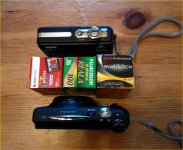
Here are two of my choices. Casio EX-Z10 from 2008 and Fuji F900EXR from 2013.
The casio still has a small optical viewfinder.
This (quick and dirty) photo was taken with a $100 smartphone.
Because of the very dim light I needed a second try. But I was able to check the result. So my phographic
enthusiasm today is to take a photo in conditions I did not think of at film times.
1/2s f3,5 ISO200 is also possible with film but sure not freehand.
If it comes to usability and compactness there are a lot of other solutions that all even can do more than the two classic film minis.

Here are two of my choices. Casio EX-Z10 from 2008 and Fuji F900EXR from 2013.
The casio still has a small optical viewfinder.
This (quick and dirty) photo was taken with a $100 smartphone.
Because of the very dim light I needed a second try. But I was able to check the result. So my phographic
enthusiasm today is to take a photo in conditions I did not think of at film times.
1/2s f3,5 ISO200 is also possible with film but sure not freehand.
jbrubaker
Established
After viewing this thread I purchased the DXO One for Android from Amazon for $139.00. I'm happy with the camera at that price. Everything works on my Samsung S21 Ultra except for the wifi, but that is not necessary as I can transfer the photos to phone storage while it's connected or just copy from the micro SD card. The photo quality is very good - better than the stock camera on my phone (which is one of the best phone cameras). I used to own a tessina many years ago but was put off by the tiny viewing screen and overall fiddly operation. Thanks for introducing me to this camera ---jb.
boojum
Mentor
I confess to owning a Pentax Q-S1 with the short and long zoom but not the super long zoom plus the prime approximate equivalent to a 50mm. This little camera punches well above its weight and has good, very good color. And a Lumix DMC-ZS3 which is also a pretty good little camera. I prefer the Pentax.
All with Pentax Q-S1 and the standard short zoom.
All with Pentax Q-S1 and the standard short zoom.
Abbazz
6x9 and be there!
I really like the DxO One because I find the field of view (roughly equivalent to a 35mm lens in 24x36 terms) more suitable for me than most digital miniature cameras (like the Sony RX0, which is more like a 28mm).After viewing this thread I purchased the DXO One for Android from Amazon for $139.00. I'm happy with the camera at that price. Everything works on my Samsung S21 Ultra except for the wifi, but that is not necessary as I can transfer the photos to phone storage while it's connected or just copy from the micro SD card. The photo quality is very good - better than the stock camera on my phone (which is one of the best phone cameras). I used to own a tessina many years ago but was put off by the tiny viewing screen and overall fiddly operation. Thanks for introducing me to this camera ---jb.
The main issue with the DxO One is that it's easy to inadvertently change the shooting mode from Still to Movie because the touch screen is quite senistive. The autofocus is also not very fast and the camera will let you press the release before perfect focus is reached. But when the planets are aligned, image quality is really good indeed.
Cheers!
Abbazz
Abbazz
6x9 and be there!
I also have a few original Pentax Q, a Pentax Q7 and a couple of Pentax Q-S1. They are very capable cameras that punch way over their weight.I confess to owning a Pentax Q-S1 with the short and long zoom but not the super long zoom plus the prime approximate equivalent to a 50mm. This little camera punches well above its weight and has good, very good color. And a Lumix DMC-ZS3 which is also a pretty good little camera. I prefer the Pentax.
They are also the perfect example of the inanity of the "equivalence theory". The "equivalence factor" of the 1/2.3" sensor of the Pentax Q compared to a 24x36 ("fullframe") sensor would be 5.6, rendering the Q totally unusable as a camera. Imagine, the standard 5-15mm f/2.8-4.5 zoom lens would become a 28-84mm f/16-25 lens. At full zoom, its maximum aperture of f/4.5 would translate into an "equivalent" aperture of f/25 on a 35mm camera. I cannot make a direct comparison because I have no 35mm lens stopping down to f/25, but I know from experience that a picture taken at f/22 would be quite blurry. But if you check the pictures online taken at f/5.6 ("equivalent" to f/31) with the Pentax Q, you will find out that they are quite sharp, much sharper in fact than pictures taken at f/22 with a 35mm camera.
Cheers!
Abbazz
Share:
-
This site uses cookies to help personalise content, tailor your experience and to keep you logged in if you register.
By continuing to use this site, you are consenting to our use of cookies.


